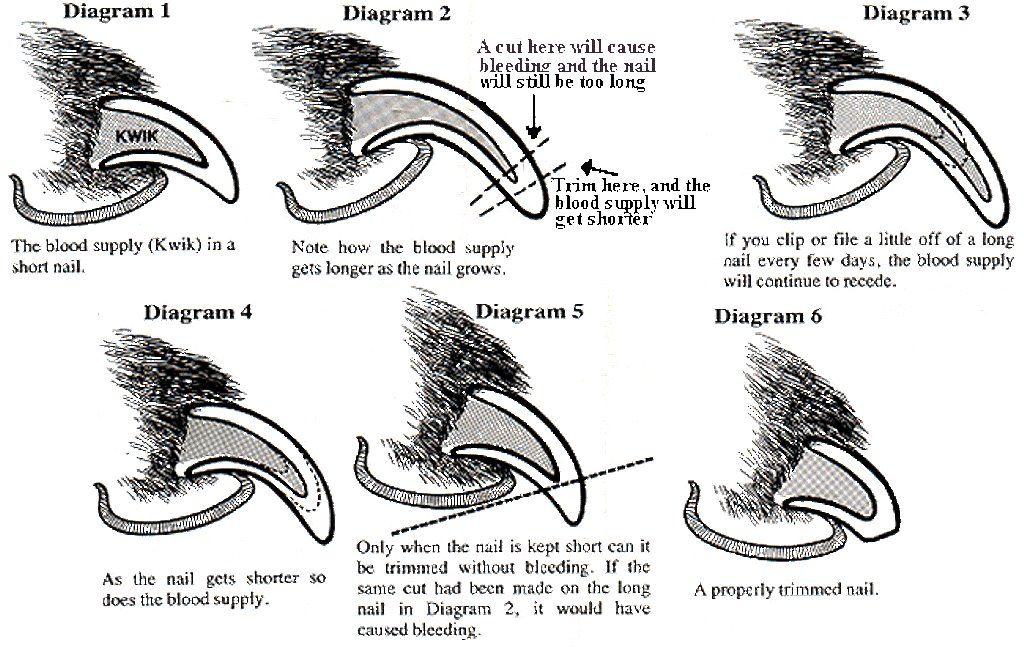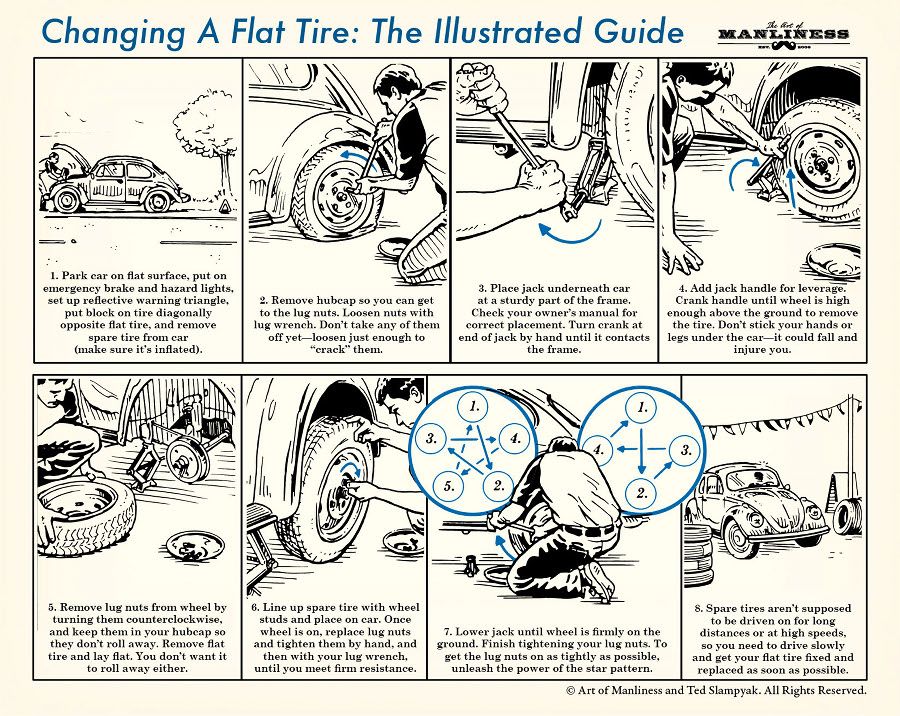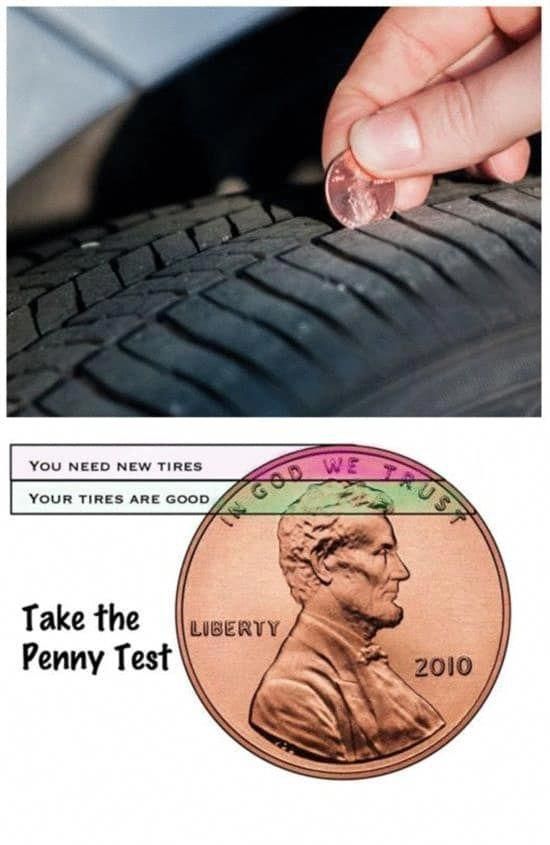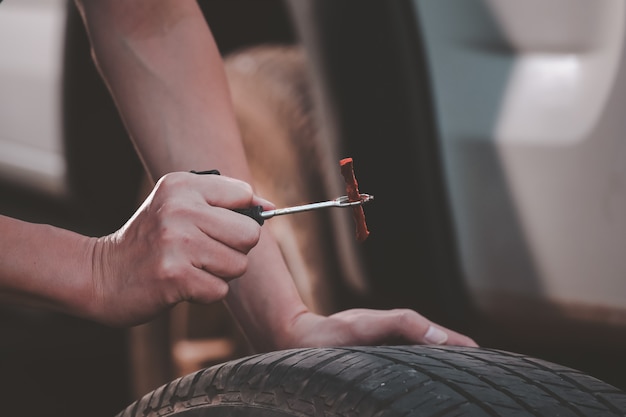Having a nail stuck in the tire of your car can be unpleasant. However, accidents happen, and the best you can do is to be well prepared. We've researched how long you can drive with a nail in your tire, so keep on reading, as we'll help you out with this unfortunate scenario.
How long you can drive with a nail in your tire will depend primarily on where the nail punctured your tire. If it punctured the center area of the tire, you might be able to drive normally for around 10 miles.
However, if it punctured near the sidewall of the tire, there is a high possibility of a blowout, and you should immediately stop the vehicle. Take note that continuing to drive while there is a nail on your tire is very dangerous, no matter the location of the puncture.
Before you continue reading, let us say we hope you find the links here useful. If you purchase something through a link on this page, we may get a commission, so thank you!
Check out the rest of this article to see what factors to consider when driving with a nail on your tire. Also, we'll teach you how to recognize the signs of a punctured tire and how to change one. Read on!
Having a nail in your tire is one of those events that all drivers will experience at some point. You may not even realize that there is a nail in your tire because of some of the factors that we will discuss here.
Size is an important factor for these kinds of scenarios. When the nail that punctures your tire is quite small, there is a chance that it may not even puncture the inner wall of the tire, and you can continue driving a short distance.
If the nail is large, you shouldn't drive for any great distance. You should have the nail removed and have the tire repaired. Just the length alone of a larger nail means it will likely puncture the tire fully.
The location of the nail also impacts how long can you drive your vehicle. If the nail punctures the tire perpendicularly and fully flushes with the surface, the distance you can drive will be longer.
The nail that punctures the tire becomes a plug that prevents air from leaking out. However, if the nail punctured the sidewall, your best bet is to have the tire replaced immediately.
Sidewall damage is different from normal tire tread puncture and is often irreparable.
The amount of air leaking from your tire is also a factor in how long you can still drive your vehicle. As long as it is not dropping rapidly, you should be fine for a few miles.
The lower the tire pressure, the higher the chance of a blowout. So keep that in mind. Check your owner's manual to find out the minimum tire pressure in which you can safely drive your vehicle.
Before your tires go completely flat, some signs could indicate there is something wrong with them. You should an idea as to what the signs are so you can prevent any further damage to your vehicle.
The signs are not that difficult to spot. Here are some of the indications that your tire might be punctured.
Here are some of the indications that your tire might be punctured.
 It will alert you if your tires are under-inflated.
It will alert you if your tires are under-inflated.There's a good chance that you will experience a punctured tire while driving. You should be prepared for this scenario. Here are some tips on what to do when you have punctured tires.
All vehicles come with a spare tire when you purchase them. The spare is specifically included on the vehicle for times like this.
To replace the punctured tire with the spare, you will need:
 Ideally, you want to change the tire on level ground to prevent your vehicle from rolling suddenly. Don't forget to apply the parking brake.
Ideally, you want to change the tire on level ground to prevent your vehicle from rolling suddenly. Don't forget to apply the parking brake. Screw the lug nuts back by hand, tightening them as much as possible.
Screw the lug nuts back by hand, tightening them as much as possible.Check this video out for a visual guide to the process:
It's always recommended to have your car fixed by a technician to ensure the quality of the fix. However, these fixes can be done DIY if you're in a pickle, and the service shop is miles and miles away.
There are three common ways of fixing a punctured tire: the plugging method, the patching method, or a hybrid of both if the puncture is complex.
The plugging method is often the easiest way of repairing minor tire punctures. The method involves the use of leather or a rubber composite that is plugged into the hole and glued in place using a rubber adhesive.
The excess leather is then cut off to create a seamless tire surface. When you start driving, the heat being generated by the tires is what causes the leather to stick onto the tire creating a permanent seal.
Check out this BETOOLL Tire Repair Kit on Amazon.
The patching method is often used for wide punctures where the plugging method cannot be used. The rubber material is patched on the inside of the tire—hence the name.
To fully bond the patch to the tire, technicians use a heat gun to speed up the process. However, the heat being generated by tires when rolling will also suffice. The patching method also creates a permanent seal on the punctured area.
Check out this Wokape Tire Patch Kit on Amazon.
For very complex punctures, a mixture of both plugging and patching is the best bet. This should only be done by a tire technician to prevent any further damage to the tire.
This method requires technical know-how and experience to be completed successfully. This can also be quite time-consuming, so it's better to leave it to the professionals.
It's never a good idea to drive with a flat tire. You're risking your safety and that of your passengers, and endangering other cars on the road. Do your research and learn what needs to be done when your tire gets punctured.
If you found this post helpful, check out some of our other posts:
How Fast Can You Go With Studded Tires?
How Long Do Spare Tires Last? [And How Far Can You Drive On Them]
Articles
Have you ever gotten a nail in your tire? You may be wondering how long can you drive with a nail in your tire. Depending on the nail and placement the time may vary. In addition, if the placement can also affect how long before your tire goes flat.
Depending on the nail and placement the time may vary. In addition, if the placement can also affect how long before your tire goes flat.
Table of Contents
If the nail in your tire is small it may not cause any issues at all. If this is the case you can drive your car until your tire tread is at a replacement height. Some nails don’t puncture the inner portion of the tire. As long as you aren’t losing air you should be able to drive quite a few miles. Just keep in mind that as you drive the nail might get closer to puncturing the inside of your tire.
If the nail is large then you may want to get it removed as quickly as possible. Larger nails puncture the interior of the tire better than small nails. That means you are more likely to have an air leak. If the air leak is bad enough you might have a completely flat tire. It’s best to get the tire repaired as soon as you can.
If you ran over a screw and it’s still in the tire you probably want to get it replaced soon. Screws can create an area for air to pass through which will probably make you have a flat tire.
Screws can create an area for air to pass through which will probably make you have a flat tire.
If the nail is in the center of the tire and you aren’t losing any air you may be able to get away with driving for a while. Although if your air pressure is going down you probably want to get it replaced as soon as possible.
If the nail is in the sidewall then the tire is ruined. Your local tire shop will have to replace the tire. Because sidewall damage is different than tire tread damage a repair cannot be made.
If your tire is leaking air due to a nail or a screw then you will want to drive to a tire shop. As long as you have 27psi or more pressure in your tire you should be able to make it. Although the lower the pressure the more likely you are to have a blowout. To be safe if you have tire pressure much lower than what your owner’s manual says then you’ll probably want to call a tow truck.
Depending on the severity and the placement of the nail your local tire repair shop should be able to repair the tire. If the nail is in or too close to the sidewall they may require you to replace the tire completely.
If the nail is in or too close to the sidewall they may require you to replace the tire completely.
It isn’t safe to repair a tire that has a nail, bulge, or puncture in the sidewall. If you can safely make it to a tire shop they should be able to give you a quote on how much it costs to repair the tire.
If you are comfortable with plugging a tire you could try a tire plug kit. These kits come with a couple of drill tools, rubber cement, and rubber plugs. By removing the screw and filling the hole with a plug you might be able to get plenty of miles out of your tire.
Although you want to make sure that you follow the instructions and don’t try to repair anything near the sidewall.
While purchasing tire insurance like road hazard won’t keep you from getting a nail in your tire it will save you from having to dish out tons of money for a new tire. Tirerack.com offers road hazard protection on their tires. This lets you have peace of mind that if your tire is damaged and repairable the road hazard insurance will usually cover the cost of the repair.
This lets you have peace of mind that if your tire is damaged and repairable the road hazard insurance will usually cover the cost of the repair.
Ivan Flyagin
Indeed, if a nail, self-tapping screw or other iron object pierces rubber with a sharp part, almost hermetically filling the hole and tightly closing it with a hat, then events can unfold in three conditional directions.
The first scenario is the most favorable, when the tire deflates very soon, and the driver discovers this at least an hour later, and the maximum the next morning. There is nothing to do - you have to go to a car service.
The second option is when a metal object is stuck in rubber so tightly and thoroughly that the air from the inside comes out very slowly and imperceptibly. The car will continue to drive with a blown tire for a long time until tire pressure loss becomes apparent. This is a completely unfavorable course of events, because it can result in the third version of the scenario - the most dangerous one.
It can never be ruled out that while driving the wheel will “catch” even a slight hole or bump, as a result of which the nail will suddenly change its location and the tire pressure will drop sharply and with the effect of an exploding bomb. The higher the speed, the worse the road and the older the tire, the more likely this unpleasant scenario, which does not exclude the most serious accident with extremely sad consequences.
There is only one conclusion: it is necessary to check the wheels of your car as often as possible for such damage. Especially after trips to the countryside and after long and long journeys. You can do this yourself by driving the car onto a lift or into a "pit", or carry out diagnostics in a tire fitting.
You can do this yourself by driving the car onto a lift or into a "pit", or carry out diagnostics in a tire fitting.
So if you notice a nail in the wheel while traveling, immediately put on a spare tire and go to the nearest tire shop. Despite the tales of some experienced drivers with many years of experience about how they calmly drove for years with nails, screws, screws, crutches, fittings and other iron products stuck in the wheel, keep in mind - even if the nail "sits" in the rubber hermetically - It's still a dangerous time bomb.
161540
We remind you of another reason to run into sanctions
33529
Another occasion to run into sanctions
,0008 33529 9000Sign up to the Avzzglygs channel:
9000 9000 9000 9000 9000 9000 9000 9000 9000 9000 9000 9000 9000 9000 9000 9000 9000 9000 9000 9000 Telegram Zen
Zen road safety, wheels, summer tires, car service, technology, repair, components, tyres, tyres, maintenance
A tire is a round piece of rubber that is the main part of a car's wheel, allowing it to move. The tire also provides traction and shock absorption while driving. Over time, stones get stuck in the tires. How to remove them, we have already told you in one of the previous articles. But stones are not the only enemies of tires. There are also nails, self-tapping screws and many other sharp objects that can easily pierce a car tire. If, having caught a self-tapping screw, a flat tire, it is clear to everyone what to do. But what if the pressure continues to hold in a punctured wheel? Can I keep driving, and if so, for how long?
See also: Is it safe to drive with a screw in a tire?
So, if you accidentally find out that a nail (or a self-tapping screw) is stuck in the wheel of your car, but the tire is still holding pressure or deflating slowly, then in no case try to pull the nail out. Leave it in the cover. Next, check the pressure in the wheel and, if it does not correspond to the one recommended by the automaker, inflate the wheel to the norm.
Leave it in the cover. Next, check the pressure in the wheel and, if it does not correspond to the one recommended by the automaker, inflate the wheel to the norm.
Otherwise, by pulling out the nail that prevents the pressure from escaping from the tire, you will flatten the tire.
There is, of course, another option - to flatten the tire, pull out the nail, take a tire repair kit and repair the puncture yourself, and then re-inflate the wheel. But, unfortunately, not every motorist has such a repair kit, and not everyone will be able to repair the wheel on their own. In fact, in order to install a tourniquet into a puncture, remarkable strength is needed.
Unfortunately, a wheel puncture with a nail or a self-tapping screw happens quite often on our roads. Many punctures do not cause the tire to flatten almost instantly. As a result, many drivers notice that the wheel caught the self-tapping screw, not immediately. True, if your car is equipped with tire pressure sensors or a wheel rotation monitoring system (the system tells the driver about a sharp change in wheel rotation parameters, which usually occur when the pressure in the wheel changes sharply), then the security system will inform you of a possible problem in wheel.
True, if your car is equipped with tire pressure sensors or a wheel rotation monitoring system (the system tells the driver about a sharp change in wheel rotation parameters, which usually occur when the pressure in the wheel changes sharply), then the security system will inform you of a possible problem in wheel.
If there are tire pressure sensors, you will be able to know which wheel has changed pressure. Unfortunately, very often this system gives false warnings (for example, when there is a sudden change in road grip or a sudden change in temperature outside). As a result, over time, many drivers stop paying attention to the warning of the tire pressure monitoring system. But in vain. After all, the system can warn of a broken wheel.
To prevent this from happening, carefully inspect the wheels for punctures after each ride. If a self-tapping screw is found, contact the tire service as soon as possible.
This is another question that is often asked by car enthusiasts on various thematic forums. We want to upset car owners right away. If you have a punctured wheel, in principle, you can not ride. After all, a car is not a toy, but a vehicle of increased danger. And not only for you and your passengers, but also for other road users. Therefore, you should contact the tire service as soon as possible, even if the punctured tire does not flatten. You are not clairvoyant and cannot know at what point the wheel will instantly lose pressure. Can you imagine what will happen if this happens at speed while driving on a motorway?
We want to upset car owners right away. If you have a punctured wheel, in principle, you can not ride. After all, a car is not a toy, but a vehicle of increased danger. And not only for you and your passengers, but also for other road users. Therefore, you should contact the tire service as soon as possible, even if the punctured tire does not flatten. You are not clairvoyant and cannot know at what point the wheel will instantly lose pressure. Can you imagine what will happen if this happens at speed while driving on a motorway?
As we have already said, it is IMPOSSIBLE to drive with a flat tire. Is it dangerous. But we understand that not everyone has a spare wheel or tire repair kit in their car. Of course, if the tire is slowly losing pressure, you can continue driving by pumping up the tire first. But you don't have to drive fast. First, it's dangerous. And secondly, the faster you drive, the faster the damaged tire will bleed air.